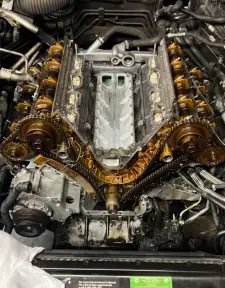
Timing Chain or Timing Belt? Those who have grappled with this question will likely know that the timing chain is maintenance-free and never needs to be replaced. In contrast, timing belts should be avoided like the plague, as they are bound to snap sooner or later, and their replacement can cost a small fortune. This viewpoint, established decades ago, conveys a deceptive sense of security: if a car has a chain, it's considered safe to purchase – but unfortunately, it's not that simple.
Where's the Difference?
Fundamentally, both timing chains and timing belts serve the same purpose: controlling the timing of valve openings. The apparent difference lies in the material used. However, a manufacturer's decision to use one over the other significantly impacts the engine's design and longevity. The latter is often associated with the timing chain, as a metal chain can endure more tension than a rubber-like belt.
Neither timing chains nor timing belts carry weights – they rotate, and do so about a million times per car journey, or roughly 30 million times a month. This immense mileage inevitably wears on the material. Here, the timing chain seems to have an advantage, but unlike the timing belt, it must be continuously lubricated with oil.
Optimal lubrication depends critically on the viscosity and quality of the engine oil. Failing to adhere to the manufacturer's specifications or delaying oil changes almost always leads to premature wear of the timing chain and consequent engine damage. Frequent short trips can also contribute to premature wear if the lubricating capacity of the engine oil diminishes due to increasing fuel ingress.
Replacement Intervals – Timing Belts and Chains

Timing belts, depending on the manufacturer, have a replacement interval between about 56,000 and 81,000 miles. Even if the vehicle is not used, the timing belt must be replaced after several years, as rubber becomes porous over time.
Furthermore, it reacts to oil and coolant, meaning leaky engines can even accelerate the decomposition of the timing belt. Various environmental factors, like extreme heat, can significantly shorten the lifespan of a timing belt. However, due to its light and soft material, the engine operates more quietly.
Timing chains generally have much longer replacement intervals than timing belts, and often, no replacement is foreseen at all. There's a distinction between link chains and roller chains. The former is cheaper to produce and runs quieter, making it preferred by many car manufacturers. The latter, while more expensive and louder, wears down slower. Roller chains are further divided into simplex (single-row) and duplex (double-row) chains. The duplex chain is more robust but causes higher friction losses due to its larger surface area.
Modern Engines with Elongated Timing Chains
Until the late 1990s, elongated or snapped timing chains were hardly a concern. However, as consumer priorities have shifted, the mere reliability of a vehicle is no longer sufficient for sales.
Exaggeratedly, today's new car buyer expects a vehicle that can do everything and costs nothing. Accordingly, a modern engine must deliver high performance and torque while being smooth-running, economical, eco-friendly, and cheap to maintain. The contradiction in some of these requirements is another matter.
Car manufacturers must meet their customers' desires, even when these expectations clash with reality. This often results in compromises at the expense of reliability, as evidenced by the diesel engine N47 from BMW or the gasoline engine M271 from Mercedes-Benz.
Conclusion: Timing Chain or Timing Belt?

As long as the timing chain is not flawed in its design and consistently supplied with high-quality oil, a timing belt can hardly compete in terms of longevity. However, whether a timing chain is better for one's car depends on several factors: one's driving profile or willingness to invest in regular maintenance. Frequent short trips are detrimental to any engine with a timing chain. Meanwhile, there are now timing belts that operate in a special oil bath, significantly extending their lifespan – for example, in the Ford Focus MK3.
Same articles

Understanding Vehicle Inspection and Verification Services: Why They Matter for Every Driver
GuidesVehicle inspection and verification services are an essential but often overlooked part of keeping roads safe and cars legally compliant. Most people only think about inspections when it’s...
KLIFEX Brand Overview: High-Quality Automotive Repair Kits for Affordable Repairs
GuidesThe automotive aftermarket has long needed solutions that combine reliability, durability, and affordability. Many car enthusiasts and services are looking for a way...
Fast, Reliable Vehicle Emissions & Inspection Services Made Simple
GuidesFast, reliable emissions and inspection services are essential for keeping vehicles road-ready, compliant with environmental regulations, and safe for daily driving. If you’re looking for quick...

